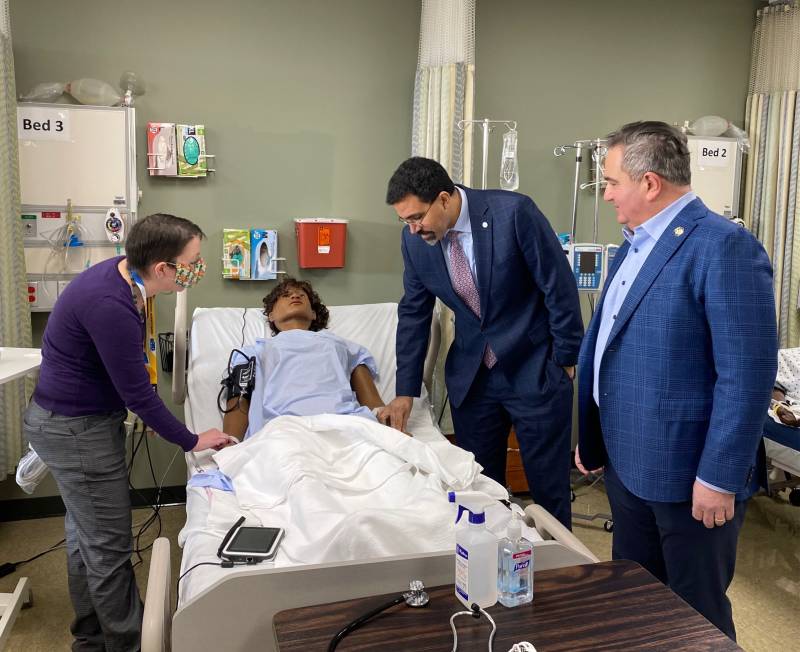
Photo by Joanne Beck
While surrounded by a group of onlookers, Madeline Wilson dramatically pumped a male’s chest with crossed hands repeatedly Thursday while watching a nearby heart monitor to see whether her actions were effective enough to resuscitate him.
Not only was she under pressure with the cardio maneuver, but she had an audience for her first attempts.
“So, especially in this, we can apply this knowledge to the community when we go into clinical and work,” the nursing student said during the demonstration at Genesee Community College’s Med-Tech building. “So if this did happen to our patient, we would be totally prepared and know what to do.”
Unlike old-school upper torso mannequins that don’t really resemble human persons besides crude physical mechanics, this male was a full-body specimen with working features. GCC purchased the $28,000 mannequin, an accompanying defibrillator and other equipment with 2024 state funding of $8 million to expand community college healthcare workforce training and mental health programs.
This investment will allow students opportunities for hands-on learning with the most up-to-date technology, officials said during a tour of the nursing, child care center and HVAC wings with SUNY Chancellor John King and Senator George Borrello.
Nursing faculty member Rebecca Herlan gave a close-up view of a mannequin, encouraging King and Borrello, who noted that the patient was even blinking, to touch the skin and feel the pulse from hands to toes.
“One of the things that we love about nursing simulation is mannequins is we can use them throughout the program. So one of the nicer things for these particular mannequins is you can see the chest, right? So some of our older model mannequins, you can't necessarily see that, and that is actually how we teach students to check, like a respiratory rate. So this is a more realistic mannequin for the students to work on,” Herlan said. “Other things you'll notice, if you actually touch the mannequin, it's more realistic skin. You can actually feel the pulses. So our old mannequins did not have great pulses. You have radial pulses, also pedal pulses, which our old mannequins definitely did not have.”
Herlan said that “we have IV access for this patient,” pointing out an adjacent IV monitor atop a pole.
“Actually, just now, Rochester hospitals are thinking of expanding what they allow students to do in terms of IV medication. So having this in the lab lets them practice sufficiently so that when they're in the clinical space, they can sort of confidently do this, but obviously, you want to have that instructor with them at all times,” she said. “But we really utilize our mannequins throughout the program, and these mannequins, as opposed to our previous mannequins, sort of have better functionality and more true to what students are actually going to see.”
The models in that room ranged from $5,000 for lower fidelity to $60,000 for a full functionality mannequin, she said. Another much more compact cut useful piece of equipment, she said, is an arm sleeve used to practice inserting an IV — “you can kind of see some of the veins” — that gets hooked up to fluid that flows through the needle to simulate when drawing blood.
King thanked Borrello for his help in getting a bill passed that increased the amount of time training nurses could spend in these simulation type exercises.
“I want to appreciate you because two years ago, we had the bill to allow the simulation to count for a third of the clinical hours. So if not for the support of the legislature, we wouldn't be able to leverage the simulation experience as effectively,” King said. “And then last year, with the $8 million in operating aid, we were able to dedicate $5 million across the system, at community colleges to healthcare workforce, and that made these purchases.”
The tour continued into the next room, which included a CPR simulation by students. The monitor has a feedback feature that shows if the compression is deep enough, are the hands in the right position, and gives “feedback in real-time,” Harlan said. Instruction also includes logistics, such as whether a student is tall enough to perform the maneuver or if a stool is needed, or if there’s no stool, “we’re climbing on the bed,” she said.
“This particular mannequin can give us that feedback on whether we're doing it appropriately. There's a lot of moving parts. So it's not a great idea to do CPR on any mannequin, but this one is specially designed, and it's really great,” she said. Like I said, we are showing the students some of the heart rhythm, help them kind of see what we were talking about in class.”
Some stats about the nursing program: there are 214 students and about 100% of them will walk away and right into a job. An amount of $310,000 was earmarked for GCC’s new Health Care Programs recruitment specialist, four new adjunct professors for the Physical Therapist Assistant and Respiratory Care programs, and to purchase equipment for respiratory care simulation education. Part of the program upgrade also includes enhanced student mentorship.
King asked what the limiting factor was for there not to be 300 students. Faculty and space, Herlan said.
Most of the students are adult learners, some come from the military, and another limitation for students living in New York City is transportation, she said. They often don’t have their own vehicle, and there’s no regular public transportation to and from GCC. After some quick head math calculating how many miles would be traveled in the program with clinicals, King nodded.
“This seems solvable,” he said, adding later that it’s a topic he will carry back with him for further discussion.
From nursing to puppies
King and his entourage, which also included GCC President Craig Lamb, stopped by the Child Care Center across the road at the main campus. Kids were excitedly chatting and playing, hitting upon a favorite subject of puppies. Lamb pulled out his phone and showed a photo of the one he has at home while King talked to a youngster at the child’s play station.
Center Director Kayleen McEwan talked about the services, facility and the fifth classroom that opened in August 2024 with funding the college received last year. No sooner had the additional room opened, and it was full, she said. When asked by King what she could she do with more resources — a question he asked of every department — McEwan didn’t take long with her answer.
“We could open eight rooms,” she said, with the caveat that staffing is a challenge.
King is aware and said so is Gov. Kathy Hochul, that childcare needs are great in New York, and SUNY’s growing population of adult learners is ripe for that service.
Keeping cool under pressure
Heating and cooling was also part of the tour, and instructor Bill Hayes exuded the enthusiasm that perhaps only a veteran HVAC business owner could display. He shared the importance of imparting his 30-year experience to students, especially when it comes to proper maintenance of appliances.
“I have a lot of people that really talk about this class. It's really a groundbreaking opportunity here for people that just walk out of here, be able to look at a furnace, look at an air conditioner, put the gauges on there, change the maintenance, oh my gosh. Maintenance is probably 50% of the problem with any type of service call; stuff's not being maintained,” Hayes said. “The college is invested here, has invested into their staff, their maintenance staff, to take this course so they can do a lot more of the HVAC work here and not have to bring in outside contractors.
"That's a huge investment for people, not only here, but also when that word gets out, there's going to be other facilities out there," he said. "They're going to want to send their people here so they can save some money. That's the game plan.”
Closing in at nearly two hours, the group ended with a talk about mental health issues and counseling challenges that most believed have been exacerbated since COVID.
Worrying about mental health
Certainly, the use of social media can be a cause of stress, and counselors also see “suicidal ideation, anxiety and panic disorders, personality disorders, autism and ADHD and major depressive disorders,” said Macy Reyngoudt, assistant director for counseling services.
“There’s lots more, but those are the biggest patterns that we see almost daily,” she said.
Remedies have included quiet meditation spaces, counseling, lots of talk and communication to let students and faculty know the counseling center is available, yoga, Mindful Mondays, and focused health talks, Assistant Dean for Student Services Monica Romeo said.
One population that hasn’t needed as much assistance is the older adult learner, Reyngoudt said, because “they’re ready” when they come to college and don’t seem to have the same problems or distractions as younger students do. That’s good news, given that Hochul’s proposed 2025 budget includes $28 million for free tuition, books, supplies and fees for adult learners to obtain an associate’s degree or certificate at community colleges in the state.
“We're very excited about the governor's proposal for free community college for folks 25 to 55 in high-demand career areas like nursing, like advanced manufacturing, like cyber security, renewable energy and green jobs. And so we're pleased that she's put real resources behind that," King said. "I think that will make a big difference as we think about what our community colleges need as we grow those high-demand workforce programs. We also need to continue to invest in equipment. We need to continue to invest in faculty, one of the big challenges for nursing. We’re looking at ways we can partner with healthcare providers to have job shares so that we have the faculty that we need.
"We need more child care in New York. You know, they have a long wait list, particularly as we try to attract more adult students to community college campuses, child care is going to be a significant factor. So that's something I'll be thinking about," he said. "It's great that they were able to use the additional resources from the governor and legislature last year to support more counseling, more services around meeting mental health needs, but more is needed, and you heard that so clearly that there is a lot of pain that folks are carrying and experiencing, some of it carrying over from COVID, and we've got to make sure that we help our campuses support student mental health needs."
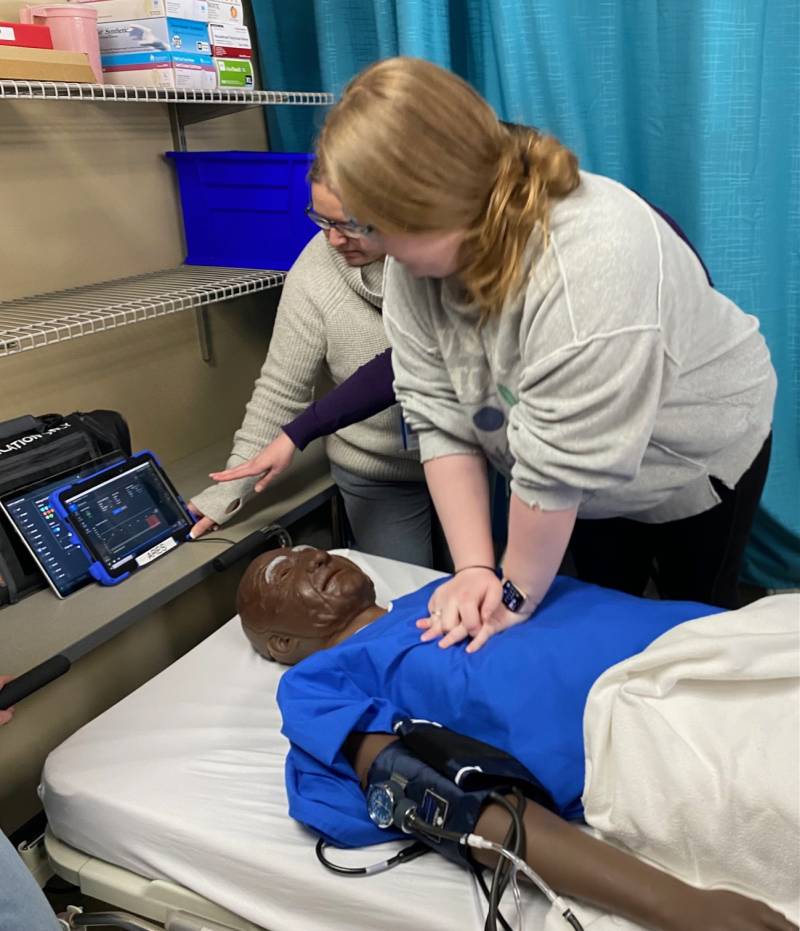
Photo by Joanne Beck
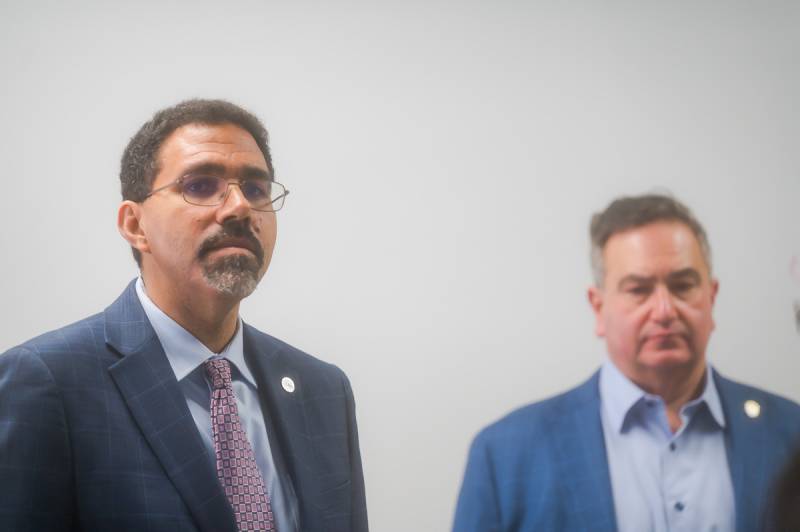
Photo by Howard Owens
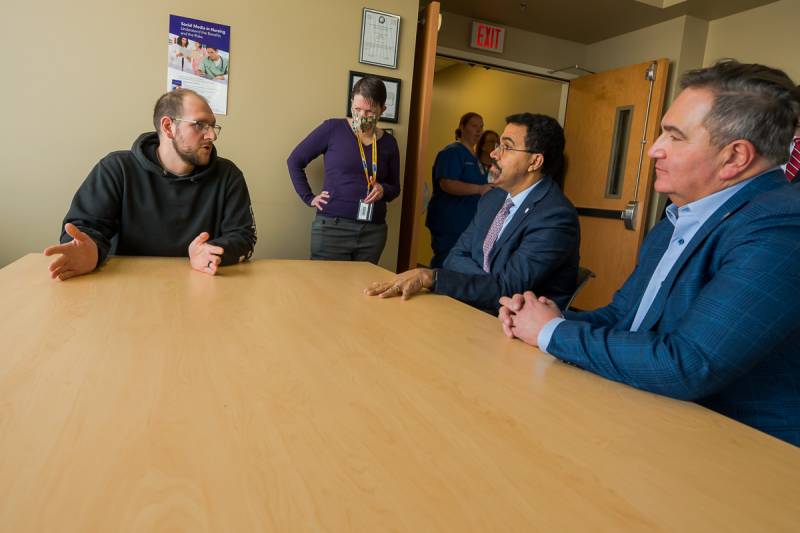
Photo by Howard Owens
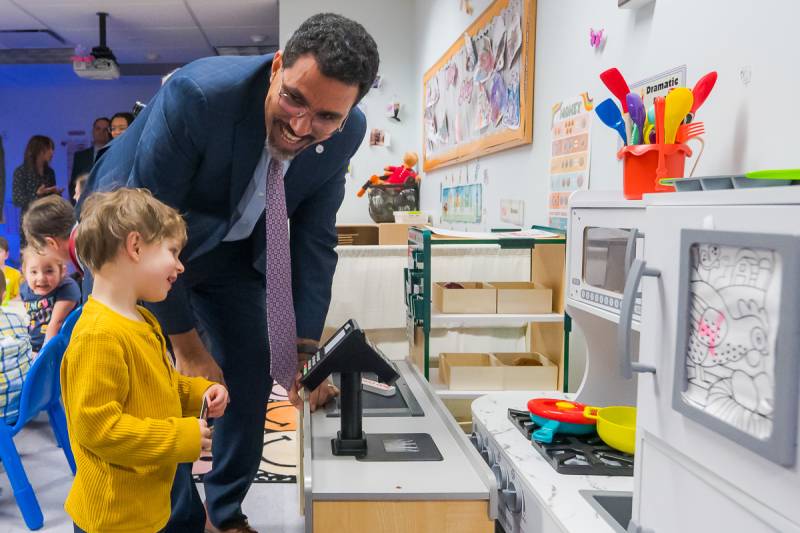
Photo by Howard Owens
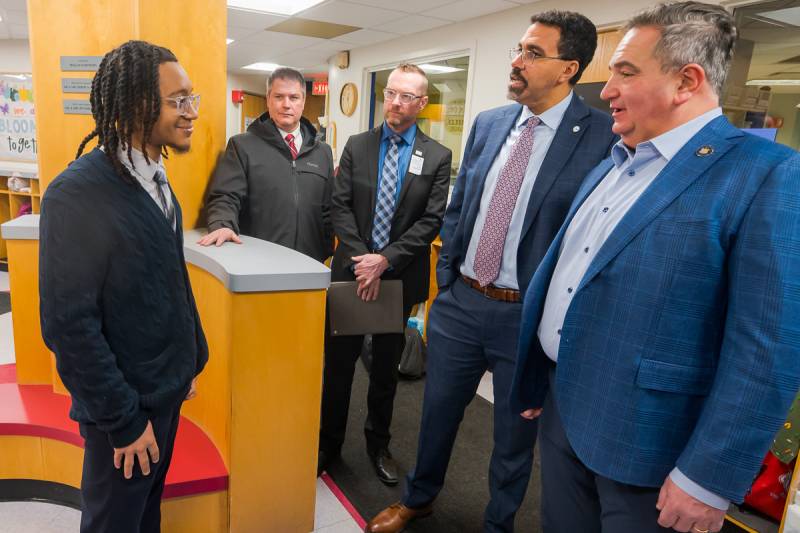
Photo by Howard Owens
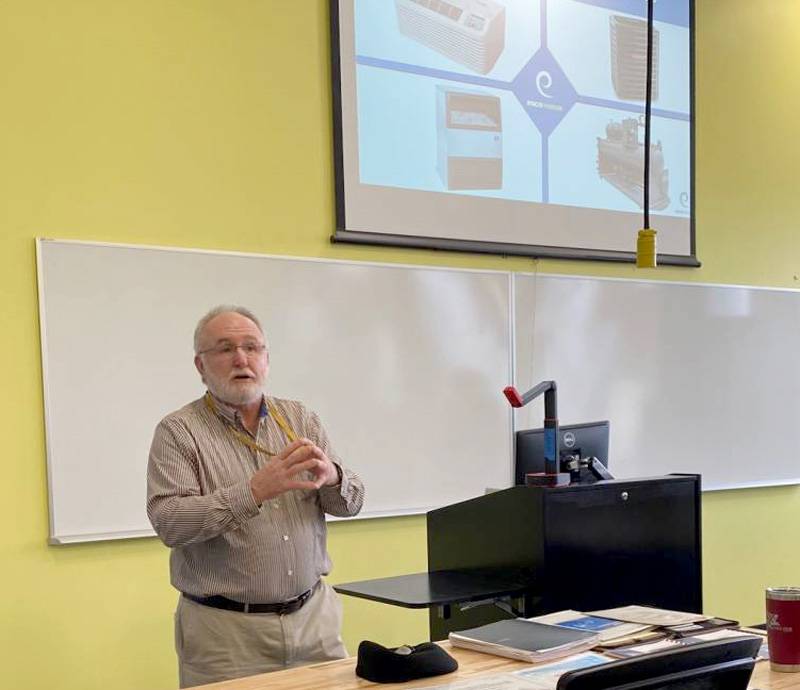
Photo by Joanne Beck
